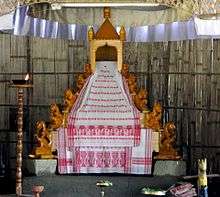Namghar
Namghars (Assamese: নামঘৰ) literally Name House are places for congregational worship associated with the Ekasarana religion of Assam.[1] In the Assamese language, 'Naam' means prayer and 'Ghar' means house. Hence, it is called Naamghar.[2] Besides forming the primary structure used for worship, they also function as meeting houses for congregations, as well as theaters for dramatic performances (bhaona). The Namghar, also called the kirtanghar, is also the central structure in the Sattras (monasteries of the Ekasarana religion) where the other buildings are positioned around it. Namghars are widespread in Assam, and very often more than one namghar exists in a single village, signifying many congregational communities.[1]
Namghars were introduced in Assam by the Vaishnavite saint Sankaradeva for Assamese people where they can culture and practice naam (devotional songs) and Bhakti of God (devotion).[3][4] He established the first Naamghar at Bordowa in Nagaon district. There is a Namghar in Puri as well, near the Jagannath Temple.[2]
Structure
Assembly Hall
The Namghar is usually a rectangular building with a gable, gablet or a hip roof raised on pillars the length of which is aligned in the east-west direction. The traditional thatch roof has been replaced in the late 20th century by corrugated tin sheets, and the timber or bamboo pillars by concrete ones. This hall usually has an outer wall (not mandatory), with the main entrance at the west end. There is a verandah around the outer wall, with windows and minor entrances on the north and south sides. Two parallel rows of pillars usually run along the length, with the northeast most pillar, called the lai khuta, carrying special significance. The hall might contain idols of mythical figures like Garuda, Hanuman, etc. that are mythological Vaishnava devotees, that face east near the western end or north and south near the eastern end. The floor is traditionally mud, replaced in recent times by concrete.[2]
Manikut

The west end of the hall does not in general have doors and windows, though very often it leads to an independent room called manikut (literally: the jewel hut), also called bhajghar in western Assam, with its own roof. It houses idols representing the worshipful god, or a guru-asana (the guru's seat). It is fully walled, with either no windows or small ones and also function as a repository of important articles. This room is a later addition to the basic namghar structure.[5]
Guru Asana
The sacred scripture is placed on the Guru Asana. The Guru Āsana, literally the Seat of the Guru is a seven-tiered, triangular, wooden throne adorned by the tortoise-elephant-lion motif and other decorative woodwork.[1]
Functions
Prayer
Primarily used as a prayer hall according to the Ekasarana traditions. Devotees sit in rows not facing the east but north and south facing each other that emphasizes the bhakat (the worshiper, or the congregation) which is one of the four reals of the religion. The region between the two north and south groups is highly sanctimonious and is never trodden on, except for cleaning. The prayers are led by the leader called naam loguwa, who sits at the end of the central region facing the sanctum sanctorum.
Cultural activities
Namghars are also used for cultural activities associated a social congregation like Bhaona (drama) and dances.
Secular activities
Namghars are used for educational, political, cultural and developmental activities and discussions undertaken in a democratic manner.
Officials
Some of the officials of Naamghar are Medhi, Bujandar, Bayan, Namgharia, Bilonia, etc.[2]
References
- 1 2 3 "The Nāmghar or Name-House". atributetosankaradeva. 2008-10-02. Retrieved 2013-04-04.
- 1 2 3 4 "Namghar - The prayer house of Assam". Joiaaiaxom.com. Retrieved 2013-04-04.
- ↑ "The Namghar | Assam Portal". Assam.org. 1998-04-10. Retrieved 2013-04-04.
- ↑ "Online Assam: Assamese Namghar, Srimanta Shankardev Namghar At Puri Sri Jagannath Dham". Onlineassam.blogspot.in. 2010-11-25. Retrieved 2013-04-04.
- ↑ The first manikut was created by Srimanta Sankardeva at Dhuwahat where he housed an idol, but later namghars that he created, like that at Patbausi did not have one (Neog & 1980 p315).
Bibliography
- Cantlie, Audrey (1984), The Assamese, London
- Neog, Maheshwar (1980). Early History of the Vaishnava Faith and Movement in Assam. Delhi: Motilal Banarasidass.
External links
| Wikimedia Commons has media related to Namghars in Assam. |
